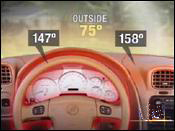
|
CONNECTIONS
|
IDAHO
ITD
HOME
IDAHO DMV
ITD NEWS
HIGHWAY
SAFETY
IDAHO STATE
POLICE
TRAVEL SERVICES
STATE OF IDAHO
NATIONAL
AASHTO
AAMVA
AAA of IDAHO
FEDERAL HIGHWAYS
FEDERAL AVIATION
IDAHO STATE POLICE
NHTSA
NTSB
TRB
U.S. DOT
Idaho
Transportation
Department
Public Affairs Office
P.O. Box 7129
Boise, ID 83707
208.334.8005
Fax: 208.334.8563
Email

Hot
cars can become deadly ovens for children
The sizzling days of summer, longed for during Idaho’s protracted wet, cool spring, finally arrived this week, sending temperatures into triple digits and children to community swimming pools.
There is little relief, however, for children left unattended in enclosed vehicles. For all of their safety features designed to protect occupants, cars can become death traps for confined children.
 Hyperthermia
(extremely high body temperatures) claimed their 11th victim of the
year this week when a 22-month-old was left for hours in a hot car outside
a Phoenix apartment.
Hyperthermia
(extremely high body temperatures) claimed their 11th victim of the
year this week when a 22-month-old was left for hours in a hot car outside
a Phoenix apartment.
The outdoor temperature hit the century mark 90 minutes before emergency crews arrived at the scene and reached a record 115 degrees later in the day. The toddler’s core temperature was 107 – after attempts to cool her down.
According to the Department of Geosciences at San Francisco State University, more children died of hyperthermia from 1998 to 2004 than as a result of hurricanes (230 to 178).
The threat is simple and severe.
In a 90-degree environment, it takes less than 20 minutes for the inside of a car to reach 125 degrees. In less than 40 minutes the inside temperature can soar to 140 degrees. A child’s body temperature rises three to five times faster than an adult’s. Left in an automobile on a hot day, children are vulnerable to heat exhaustion and hyperthermia.
Symptoms include lethargy, dehydration, vomiting, diarrhea and a body temperature of up to 104 degrees, according to the Texas Children’s Hospital. Children lose their ability to sweat, resulting in seizures, stroke and ultimately death.
Temperatures do not need to reach triple digits to pose life-threatening conditions for children.
Consider a study in 2002 of a dark blue mid-size sedan with a medium gray interior.
Temperatures on 16 random summer days ranged between 72 and 96 degrees. Inside the test vehicle, the temperature rose an average of 19 degrees in 10 minutes, 29 degrees in 20 minutes, 34 degrees in 30 minutes and 43 degrees in an hour. Leaving the window down slightly produced little relief. Vehicle interior colors appear to be a major factor in how rapidly automobile temperatures rise.
-
Do not leave a child in an unattended car, even with the windows down.
-
Make sure all occupants leave the vehicle when unloading. Don’t overlook sleeping babies. Check all vehicle seats.
-
Patronize businesses that have drive-through windows or curbside service when running errands.
-
Pay at the pump when refueling so you can watch your children.
-
Always lock your car. If a child is missing, check, the car first, including the trunk. Teach your children that vehicles are never to be used as a play area.
-
Keep a stuffed animal in the car seat, and when the child is put in the seat place the toy in the front as a reminder that a child is in back.
-
Place an item that you will need to take with you, such as a purse or briefcase, in the back seat so you will notice the child in back.
-
Have a plan that your childcare provider will call you if your child does not show up as scheduled.
-
If you notice a child left unattended in a vehicle, call 9-1-1 immediately. If it is very hot and the child is unresponsive, break the window to ventilate the car; apply cardio pulmonary resuscitation techniques to the child if you are so trained.
-
Apply cool, wet compresses or ice to reduce the child’s core body temperature.